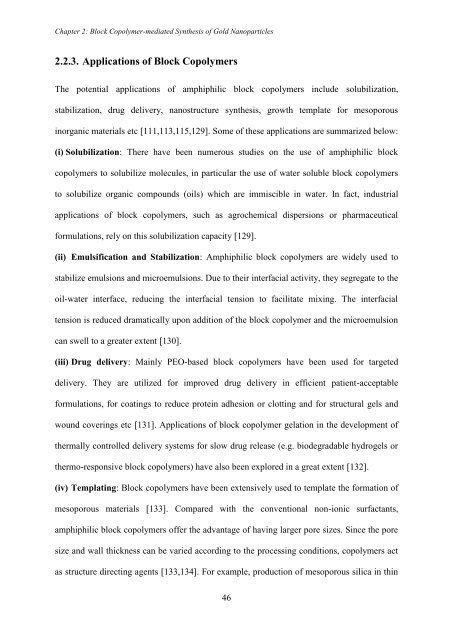PHYS01200704032 Debes Ray - Homi Bhabha National Institute
PHYS01200704032 Debes Ray - Homi Bhabha National Institute
PHYS01200704032 Debes Ray - Homi Bhabha National Institute
You also want an ePaper? Increase the reach of your titles
YUMPU automatically turns print PDFs into web optimized ePapers that Google loves.
Chapter 2: Block Copolymer-mediated Synthesis of Gold Nanoparticles<br />
2.2.3. Applications of Block Copolymers<br />
The potential applications of amphiphilic block copolymers include solubilization,<br />
stabilization, drug delivery, nanostructure synthesis, growth template for mesoporous<br />
inorganic materials etc [111,113,115,129]. Some of these applications are summarized below:<br />
(i) Solubilization: There have been numerous studies on the use of amphiphilic block<br />
copolymers to solubilize molecules, in particular the use of water soluble block copolymers<br />
to solubilize organic compounds (oils) which are immiscible in water. In fact, industrial<br />
applications of block copolymers, such as agrochemical dispersions or pharmaceutical<br />
formulations, rely on this solubilization capacity [129].<br />
(ii) Emulsification and Stabilization: Amphiphilic block copolymers are widely used to<br />
stabilize emulsions and microemulsions. Due to their interfacial activity, they segregate to the<br />
oil-water interface, reducing the interfacial tension to facilitate mixing. The interfacial<br />
tension is reduced dramatically upon addition of the block copolymer and the microemulsion<br />
can swell to a greater extent [130].<br />
(iii) Drug delivery: Mainly PEO-based block copolymers have been used for targeted<br />
delivery. They are utilized for improved drug delivery in efficient patient-acceptable<br />
formulations, for coatings to reduce protein adhesion or clotting and for structural gels and<br />
wound coverings etc [131]. Applications of block copolymer gelation in the development of<br />
thermally controlled delivery systems for slow drug release (e.g. biodegradable hydrogels or<br />
thermo-responsive block copolymers) have also been explored in a great extent [132].<br />
(iv) Templating: Block copolymers have been extensively used to template the formation of<br />
mesoporous materials [133]. Compared with the conventional non-ionic surfactants,<br />
amphiphilic block copolymers offer the advantage of having larger pore sizes. Since the pore<br />
size and wall thickness can be varied according to the processing conditions, copolymers act<br />
as structure directing agents [133,134]. For example, production of mesoporous silica in thin<br />
46

















